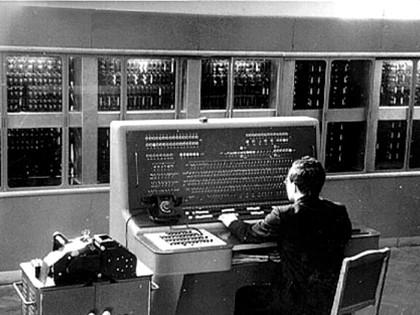Sent to you by Sparkie via Google Reader:
Up until his death last year, my great uncle Bora Rachman was curator of the Popov technology museum in St Petersburg. He let me do a ton of photography the last time I visited him (alas, my camera broke that day, necessitating the use of a crummy phonecam). Lots of shots of handsome old Soviet clunker computers.
Building digital computers in Soviet post-war Russia was a dangerous business. To protect himself and his staff from criticism that could end in them being sent to labour camps, Russian computer pioneer Sergei Lebedev of the Kiev Electro-Technical Institute declared that the computers they wanted to build would carry out only ideologically correct calculations.Described as 'the Soviet Alan Turing', Lebedev had been thinking about how to build a computer since 1948, and by the end of 1949 he had the basic principles down on paper. In a climate of deep suspicion, Lebedev assembled a team of 12 designers and 15 technicians at a disused monastery at Feofania, near Kiev, and gave it the seemingly ironic name 'Secret Laboratory Number One'...
The Russian System/360 clone was called the ES EVM, and it soon became widely available in Russia. In 1972, the year that the ES EVM was released, Soviet leader Leonid Brezhnev virtually admitted what was going on when he told a meeting of officials, "We communists have to string along with the capitalists for a while. We need their credits, their agriculture and their technology."
Theft quickly became the principal way that Russian computing kept pace with the West. In 1975, production began of a clone of the influential DEC PDP-11/40 minicomputer. Called the SM-4, it featured multiple video terminals and twin magnetic tape units - just like the real thing. The SM-4 so faithfully reproduced the original hardware that it even ran Unix, enabling it to run a wide range of stolen applications.
The successor to the SM-4 was the SM-1420. A cloned version of the DEC PDP-11/34+, it was produced in large numbers across the Soviet Union. The standard machine had 256kb of RAM, two 2.5MB removable disc packs, two magnetic tape drives and the ability to handle several video terminals. Predictably, the mid-1980s saw the first cloned Russian IBM PC, called the ES PEVM. It ran DOS and early versions of Windows.
Secrets of Communist computing (Thanks, Steve!)
Things you can do from here:
- Subscribe to Boing Boing using Google Reader
- Get started using Google Reader to easily keep up with all your favorite sites

No comments:
Post a Comment